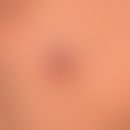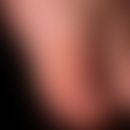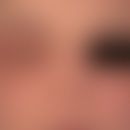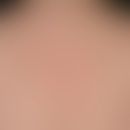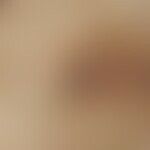Synonym(s)
DefinitionThis section has been translated automatically.
Chronic hair follicle inflammation, which is characterized by curved growing hair shafts in the beard area but also in other regions. The hair shafts grow transfollicularly into the surrounding skin and cause an inflammatory foreign body reaction there (Ogunbiyi A 2019).
EtiopathogenesisThis section has been translated automatically.
Particularly during wet shaving, also during mechanical and chemical epilation, sharp whisker tips develop in the acroin fundibulum, which bend sharply and drill into the transfollicular connective tissue through the follicular epithelium. Hair shafts that reach the epidermal surface can grow back into the epidermis. Rolling up of the hair. Chronic perifollicular foreign body reaction.
You might also be interested in
ManifestationThis section has been translated automatically.
Frequently occurring in members of dark-pigmented, Mediterranean or African ethnic groups.
Predominantly men with strong beard growth are affected.
LocalizationThis section has been translated automatically.
Clinical featuresThis section has been translated automatically.
Thick, inflammatory, reddened, perifollicular nodules and pustules. Postinflammatory: hyperpigmentation or comedones.
HistologyThis section has been translated automatically.
Foreign body granuloma (trichogranuloma) at the point of penetration of the whiskers.
Differential diagnosisThis section has been translated automatically.
Complication(s)This section has been translated automatically.
Disposed patients may develop keloids and unsightly scarring.
General therapyThis section has been translated automatically.
Leave the beard standing, thus avoiding the re-growth of short, curled whiskers (simplest method). Already ingrown hairs must be freed individually or completely epilated.
Alternative: Very careful wet shave without applying pressure to the skin with hair removal creams containing thioglycolate; this will not irritate the hair follicle. Hair is cut off at the skin level and therefore cannot grow into the follicular canal or perifollicularly.
Notice! Do not shave electrically! Hair is cut too irregularly and too long; flat growing hair is not detected). Either let the beard grow or shave very carefully!
External therapyThis section has been translated automatically.
Progression/forecastThis section has been translated automatically.
LiteratureThis section has been translated automatically.
- Daniel A et al (2013) Shave frequency and regimen variation effects on the management of pseudofolliculitis barbae. J Drugs Dermatol 12:410-418
- Ladizinski B et al (2013) Pseudofolliculitis barbae: a dermatoscopic correlate. Dermatol Pract Concept 3:53-54
- Leheta TM (2010) Comparative evaluation of long pulse Alexandrite laser and intense pulsed light systems for pseudofolliculitis barbae treatment with one year of follow up. Indian J Dermatol 54:364-368
- Nguyen TA et al (2014) Pseudofolliculitis Barbae in Females: A Clinical Perspective. Br J Dermatol doi:10.1111/bjd.13644
- Ogunbiyi A (2019) Pseudofolliculitis barbae; current treatment options.
Clin Cosmet Investig Dermatol 12:241-247. - Rodney IJ et al.m (2013) Hair and scalp disorders in ethnic populations. J Drugs Dermatol 12:420-427
Outgoing links (9)
Acne (overview); Candidoses; Folliculitis gramnegative; Folliculitis (overview); Foreign body granuloma; Hyperpigmentation; Komedo; Solutions; Trichophytosis;Disclaimer
Please ask your physician for a reliable diagnosis. This website is only meant as a reference.
